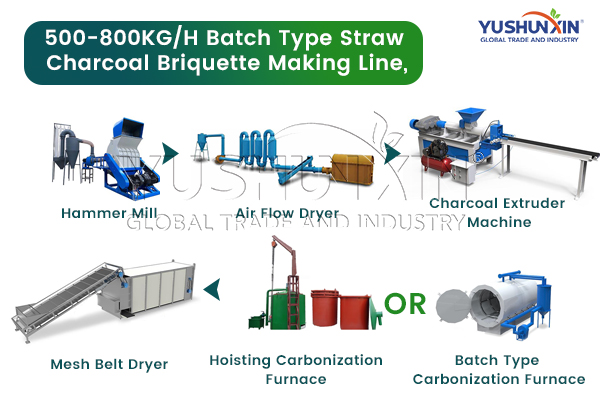
As the world grapples with the challenges of sustainable energy production and waste management, the conversion of agricultural residues into biofuels presents a promising solution. Straw charcoal briquettes, made from leftover straw, offer a renewable energy source that reduces waste and mitigates environmental impact. This passage outlines the intricate process of transforming straw into charcoal briquettes, highlighting the key stages and machinery involved.
Collection and Preparation of Straw
Harvesting and Gathering
The journey of straw charcoal briquettes begins in the fields. Agricultural residues like rice straw, wheat straw, and corn stalks are collected post-harvest. These by-products, often considered waste, become the primary raw materials for briquette production. Efficient collection and storage are crucial to ensure a constant supply while preventing decomposition and moisture absorption, which could affect the quality of the final product.
Drying Process
Before processing, the gathered straw must be thoroughly dried to reduce moisture content. Drying is essential because high moisture levels can impede carbonization and compromise briquette quality. Natural sun drying is a cost-effective method, though industrial drying machines can be employed for accelerated drying, particularly in regions with high humidity or during rainy seasons.
Carbonization of Straw
Pyrolysis Techniques
The dried straw is subjected to carbonization, a thermal decomposition process that occurs in the absence of oxygen. This process, known as pyrolysis, involves heating the straw in specialized kilns or retorts to convert it into charcoal. The kilns are designed to maintain optimal temperatures and prevent oxygen infiltration, ensuring efficient carbonization. The result is a lightweight, carbon-rich material that forms the foundation for briquette production.
Cooling and Crushing
Once carbonization is complete, the charcoal is allowed to cool before being crushed into fine particles. Crushing is a critical step as it ensures uniformity in particle size, which is necessary for consistent briquette formation. Advanced crushing machines can efficiently break down charcoal into the desired granularity, enhancing the quality and durability of the final briquettes.
Briquette Formation and Drying
Mixing and Binding
The crushed charcoal is then mixed with a binding agent to facilitate cohesive briquette formation. Common binders include starch, clay, or other natural adhesives. The mixture is thoroughly blended to ensure even distribution of the binder, resulting in a malleable yet firm composition ready for briquetting.
Briquette Molding
The blended mixture is fed into briquetting machines, where pressure and, sometimes, heat are applied to mold the charcoal into uniform, dense briquettes. These machines, equipped with various molds, can produce briquettes of different shapes and sizes to meet specific market demands. High-pressure briquetting ensures the integrity and longevity of the briquettes during handling and combustion.
Final Drying
After molding, the briquettes undergo a final drying phase to remove residual moisture and harden the structure. Industrial dryers or natural sun drying can be employed, depending on the production scale and environmental conditions. Properly dried briquettes exhibit high energy efficiency and produce minimal smoke and ash during combustion.
Conclusion
The production of straw charcoal briquettes is a multifaceted process that transforms agricultural waste into a valuable energy resource. By utilizing specialized techniques and equipment, this process not only contributes to waste reduction but also offers an eco-friendly alternative to traditional fossil fuels. As the demand for sustainable energy solutions grows, straw charcoal briquettes stand out as a practical and environmentally sound choice that supports both rural economies and global sustainability efforts. Visiting: https://www.char-molder.com/product/straw-charcoal-briquette-plant/
Leave a Reply